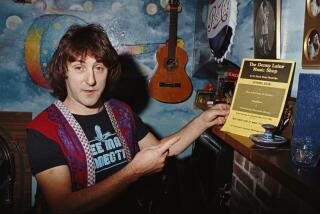Man of Many Melodies
- Share via
The youth and vigor that George Van Eps instills in his guitar artistry make it hard to believe he’ll turn 84 on Aug. 7. He doesn’t seem to buy it, either. “I’m just a kid,” he says, laughing.
Then, in his typically soft voice, he adds something that takes away the air of joviality: “I wasn’t supposed to live past 20. That’s what I heard a doctor tell my parents.”
Van Eps, who grew up on Long Island, contracted rheumatic fever at age 9 and spent over a year in bed. It turned out to be an auspicious year for, during it, he learned to play banjo. Van Eps comes from a musical family: His father was a famous banjoist who for a time employed George Gershwin as his accompanist; his mother was a first-rate pianist; and his three brothers all became top-level pros.
Somehow, despite an enlarged heart with a leaking valve, Van Eps recovered sufficient health to start playing banjo professionally at age 11. “I was a ham. I’d play for anyone who’d listen,” he says.
He switched to guitar two years later and went on to play with Benny Goodman, Ray Noble (composer of “Cherokee” and other classics), Red Norvo and so many others. His latest recording, 1996’s “Legends,” co-led with Johnny Smith, accurately states his position in the jazz world--not that he likes the appellation.
“I cringe when people call me a living legend,” he says during a phone interview from his Huntington Beach home. “Though I do think some people come out to see if I’m still alive.” He chuckles again.
Van Eps appears with trombonist-euphonium player Betty O’Hara and bassist Bob Maize tonight at Chadney’s in Burbank. There, he’ll reward his fans and those who have never heard him with his subtle powers: an ability to play lush, moving chords that seem to float lingeringly in the air, and his singular way of offering enchanting themes and inventive variations.
The guitarist explains his approach to improvisation. “Some people who have good technique like to play a lot of up-tempos. I don’t care,” he says. “I like to play things that people can understand, that I can understand. All the notes I play are melodies, and I try to make them kissing cousins: They have to get along together.
“The main objective is to make it a musical experience. Music, in big capital letters, comes first. A tune doesn’t have to go like a scared rabbit at a ridiculously fast tempo to be exciting. I’ve heard things that were so slow you could drive a Mack truck between the notes, and I came right out of my chair, it was so exciting.”
As for what tunes he might play tonight, Van Eps is leaving things open. “I like to surprise people. I like to play things I haven’t heard.”
Van Eps took to guitar because he was thrilled by the harmonies his mother and brother played on the piano. “I wanted to adapt that to a stringed instrument, and I was drawn to the singing, sustained-note quality of the guitar.”
Later, while a studio musician in Hollywood in the ‘40s, Van Eps designed the seven-string guitar. “I wanted a guitar that was like a piano,” he said, “where I could play anything, even bass notes, that I thought of.”
The guitarist’s career has many wondrous memories. There were the pre-rheumatic-fever days, when Gershwin would come to the Van Eps’ home in Plainfield, N.J., to rehearse with George’s father. “He’d bounce me on his knee as he played the piano,” Van Eps recalled. “Then later I met him as an adult and performed on the soundtrack of his last film, ‘Damsels in Distress.’ ”
Benny Goodman, often cited for his self-centeredness as well as his artistry, also gets high marks from Van Eps. “We were good friends. I loved him,” says the guitarist. “Once, when an uncle of mine had died [in the ‘30s] and the family was pinched for money, Benny gave me $1,000.”
*
BE THERE
George Van Eps plays tonight, 9-1 a.m., at Chadney’s, 3000 W. Olive St., Burbank. No cover, one-drink minimum per show. (818) 843-5333.
More to Read
The biggest entertainment stories
Get our big stories about Hollywood, film, television, music, arts, culture and more right in your inbox as soon as they publish.
You may occasionally receive promotional content from the Los Angeles Times.






